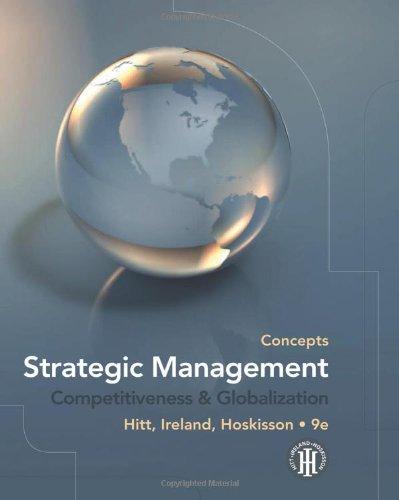The focus of this chapter is on understanding how firm resources and capabilities serve as the cornerstone
Question:
The focus of this chapter is on understanding how firm resources and capabilities serve as the cornerstone for competencies, and, ultimately, a competitive advantage. However, when firms cannot create value in either a primary or support activity, outsourcing becomes a potential strategy. Yet with the recession that began in 2007 there seems to be a shift occurring. According to the International Association of Outsourcing Professionals (IAOP) at their 2008 annual conference, nearly 75 percent of organizations will do the same or more outsourcing in response to the financial crisis and that greater contract flexibility is their top need. However, 25 percent of organizations reported lower volumes and 19 percent said they have renegotiated lower prices on existing contracts. In addition, the IAOP reports more than 53 percent of respondents say they are doing more due diligence and also favor working with larger providers.
During that same 2008 conference, the IAOP announced their Global Outsourcing 100, a ranking of the world’s best outsourcing service providers. The evaluation process mirrors that employed by many top customers and considers four key criteria:
(1) size and growth in revenue, employees, centers, and countries served; (2) customer experience as demonstrated through the value being created for the company’s top customers;
(3) depth and breadth of competencies as demonstrated through industry recognition, relevant certifications, and investment in the development of people, processes, and technologies; and (4) management capabilities as reflected in the experience and accomplishments of the business’s top leaders and investments in management systems that ensure outsourcing success. Below are the top 10 for 2008.
1. Accenture 2. IBM 3. Infosys Technologies 4. Sodexo 5. Capgemini 6. Tata Consultancy Services 7. Wipro Technologies 8. Hewlett-Packard 9. Genpact 10. Tech Mahindra Split up into groups and pick one of the Global Outsourcing 100 to analyze. The complete list can be found on the IAOP website at http://www.outsourcingprofessional.org/. (A new list is published annually in Fortune magazine and updated on the IAOP website.) Prepare a brief presentation using your research and the contents of this chapter that addresses at a minimum the following questions:
• Why was this company chosen? What has been their history as regards outsourcing as a source of revenue?
• How does the firm describe, or imply, its value proposition?
• What unique competitive advantage does the firm exhibit?
• Do you consider this to be a sustainable competitive advantage? Utilize the four sources of sustainable competitive advantage as your guide.
What makes one team successful while another team struggles?
At first glance, a National Football League franchise or Women’s National Basketball Association team may not seem like a typical business. However, professional sports have been around for a long time: pro hockey in the United States emerged around World War I, and pro basketball shortly after World War II; both could be considered newcomers relative to the founding of baseball leagues. Pro sports are big business as well, as evidenced by the Boston Red Sox’s 2009 opening day payroll of $121,745,999.
With this exercise, we will use tools and concepts from the chapter to analyze factors underlying the success or failure of different sports teams. Working as a group, pick two teams that play in the same league. For each team, address the following questions:
• How successful are the two teams you selected? How stable has their performance been over time?
• Make an inventory of the characteristics of the two teams.
Characteristics you might choose to identify include reputation, coaching, fan base, playing style and tactics, individual players, and so on. For each characteristic you describe:
• Decide if it is best characterized as tangible, intangible, or a capability.
• Apply the concepts of value, rarity, imitation, and sustainability to analyze its value-creating ability.
• Is there evidence of bundling in this situation (i.e., the combination of different resources and capabilities)?
• What would it take for these two teams to substantially change their competitive position over time? For example, if a team is successful, what types of changes in resources and capabilities might affect it negatively? If a team is below average, what changes would you recommend to its portfolio of resources and capabilities?
Step by Step Answer:

Strategic Management Concepts Competitiveness And Globalization
ISBN: 9780538753098
9th Edition
Authors: Michael A. Hitt, R. Duane Ireland, Robert E. Hoskisson





